
WASHINGTON COUNTY — Four new paleontological sites were discovered during the Southern Parkway project in Washington County, and 10 previously known localities were surveyed for additional paleontological resources. Paleontologist Andrew Milner shares his findings, some of which may be entirely new discoveries to science.
Earlier this year archaeologists from the consulting company William Self Associates employed by the Utah Department of Transportation discovered and excavated ancient ruins as they surveyed their way through the Southern Parkway, a 33-mile project that will soon be an eastern belt route for Washington County.
The ruins have been named one of the oldest sites investigated in Southern Utah, situated where more than 15 other archaeological sites have been found near Washington Dam Road in Washington.
Archeologists stated in an earlier report this year that upon significant research, the area was inhabited by humans for up to 10,000 years. Among the list of items, as previously reported, were Anasazi pit houses, arrowheads, and pottery calibrated to date back as far back as 400 B.C.
Paleontologist Andrew Milner was hired on by William Self Associates as the firm’s consulting paleontologist to investigate the paleontological resources along the Southern Parkway Project route. He is also the paleontologist and curator at the St. George Dinosaur Discovery Site at Johnson Farm, where he specializes in dinosaur tracks and other fossils from the Triassic and Early Jurassic periods, with rocks that he said range in age from 230 million to 190 million years old.
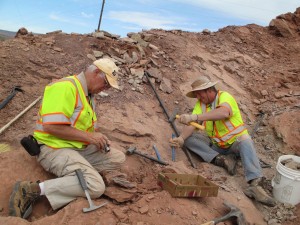
Paleontology and archaeology are often confused with one another, Milner said. While archaeologists study past human life and culture by the recovery and examination of remaining material evidence, such as graves, buildings, tools and pottery, paleontologists study prehistoric life forms such as animals and plants, through their fossils preserved through geologic time.
“The confusion between these two sciences occurs when archaeologists study fossils that have been used by ancient human populations,” Milner said. “For example, when animal remains are found with evidence of humans such as stone tools, cut marks on mammoth bones, and so on.”
Fossils discovered along the Southern Parkway
Four new paleontological sites were discovered during the project, and 10 previously known localities were surveyed for additional paleontological resources. Two of these localities turned out to be of critical importance for paleontologists, Milner said.
Both sites are from the early Jurassic Kayenta Formation, Milner said, which consists of rocks that are about 195 million to 190 million years old.
The first locality was excavated in 2011-2012 and revealed more than 600 dinosaur tracks preserved along the shores of an ancient river that flowed from the southwest to the northeast before the Rocky Mountains had formed.
Most of the footprints preserved were made by small plant-eating dinosaurs, Milner said. Other tracks include those of large and small meat-eating dinosaurs and rare prints of extinct crocodile relatives. Although this site is now completely buried beneath some 15 feet of road fill, Milner and his team of dedicated volunteers mapped, photographed, measured, and had the entire site laser-scanned in order to preserve a detailed record of the site. Replicas of some of the more important tracks were made and collected for further study.
All of the tracks collected from this site are now held in the Natural History Museum of Utah in Salt Lake City.

“The second locality is even more unique,” Milner said. “The Kayenta Formation in southwestern Utah has many important fossil sites, but the majority of them only preserve tracks. Body fossils, such as bones, teeth, shells and plants, are very rare in the region, but this new site produced over a thousand body fossils including tracks.”
Of these, he said, about 100 fossil teeth have been found and so far they represent seven different kinds of reptiles. These include both large and small serrated dinosaur teeth, small leaf-shaped teeth probably from an unknown species of plant-eating dinosaur, teeth from extinct relatives of modern crocodiles and alligators, and two kinds of teeth from unknown reptilian predators.
Milner has shown these teeth to other paleontologists that specialize in Late Triassic-Early Jurassic reptiles and they agree that 4 of the 7 tooth shapes are new to science.
“Also from this site,” Milner said, “several well-preserved fossil fishes were found and hundreds of well-preserved plant fossils, mostly cycad leaves, although conifers—relatives of modern pine and fir trees—horsetail plants, and rare ferns were discovered.”
These plants represent the first identifiable plants ever found in the Kayenta Formation, he said, and along with the other fossils, help paleontologists reconstruct what life was like some 195 million years ago in the American Southwest during the early stages of the dinosaur record.
“Like the previous site,” Milner said, “this locality is now buried under several feet of road fill, but large amounts of important scientific information have been tediously gathered for scientific and educational purposes.”
The team also found a lot of cycads, which are a type of seeded plant typically characterized by a stout and woody trunk with a crown of large evergreen leaves that superficially resemble ferns. Cycads were very common during the Jurassic Period.
Preservation and cultural interests
A large part of this collection will be housed at the Natural History Museum of Utah and the St. George Dinosaur Discovery Site at Johnson Farm. Smaller collections will go to Dixie State University, Southern Utah University, and other museums across the United States including the Field Museum of Natural History in Chicago.
“The excavation of paleontological resources along the SPP route did not slow down or hinder construction efforts in any way,” Milner said. “Since construction crews were dealing with such a huge area to work with, in spring 2013, we spent three weeks excavating the plant locality while big machinery removed rock all the way around our crew.”
“Finally, UDOT helped us out by transporting four dump truck loads of rock to the SGDS so we could continue to process it for more reptile teeth and other vertebrate fossils,” Milner said. “Research on this locality will be going on for many years to come.”
What happened to the rest?
“Some things get lost,” Milner said of the Southern Parkway Project. “There’s so much rock out there you can’t look at everything. It’s not like an archeological site where you see stuff on the surface.”
Milner said they had a group of volunteers with a keen eye and that the majority of their findings are typically tracks.
Community resources
While Milner said he is excited by these new discoveries, he also finds it frustrating.
“When I first started the SPP I wasn’t expecting to make such important discoveries,” Milner said.
“It started off as a small side project that grew into a monster,” he said. “Our preparation lab at the SGDS is not very big and only provides space for a few people working at one time. The lack of space at the SGDS is one of biggest problems and with all of the important fossils being found in southwestern Utah it’s not getting any easier.”
Milner said the Discovery site needs an additional building either on- or off-site from the SGDS for fossil preparation, collection storage and research/educational purposes and that many important fossils are still stored outdoors in wooden boxes which, he said, are degrading due to harsh desert conditions.
“They are safe in the ground,” Milner said, “but once excavated they’re exposed to the elements and quickly break down.”
“Our limited staff and army of volunteers work very hard to preserve them, but it’s a constant battle again the elements,” Milner said. “The SGDS has the world’s large and best-preserved collection of dinosaur swim tracks ever discovered that still hold tons of valuable information on early meat-eating dinosaur behavior, but without better protection these unique and valuable fossils will be lost forever.”
“The museum basically keeps itself running by admissions and gift shop sales,” Milner said. “We have very little in the way of funds to build on what we have although we are trying very hard.”
Click on photo to enlarge it, then use your left-right arrow keys to cycle through the gallery.
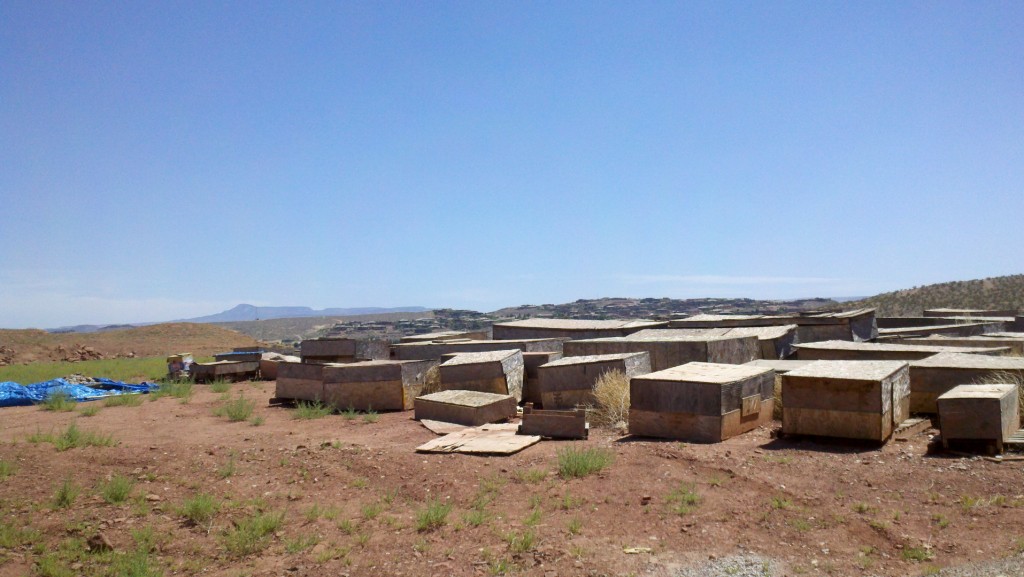
Homemade wooden boxes covering blocks of dinosaur tracks behind the Dinosaur Discovery Site. St. George, Utah, May 2013 | Photo by Sarah Isaacson, St. George News

View inside specimen cabinet. Drawer open contains Cycad leaves from Southern Parkway Project. St. George, Utah, May 2013 | Photo by Sarah Isaacson, St. George News
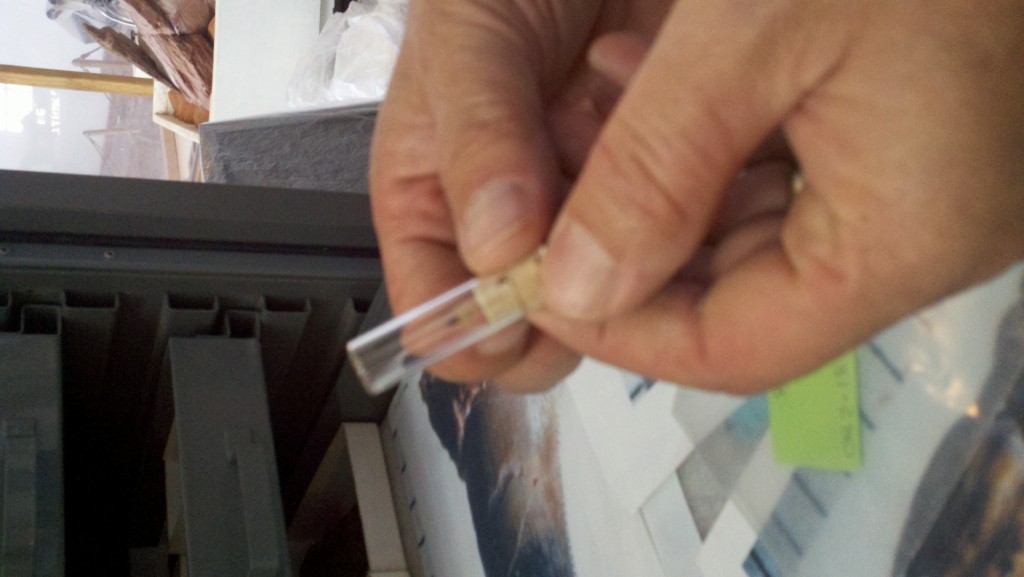
Prepared reptile tooth in vial and mounted on the head of a pin so that it can easily be studied/photographed under a microscope and the fossil doesn't have to be touched. St. George, Utah, May 2013 | Photo by Sarah Isaacson, St. George News
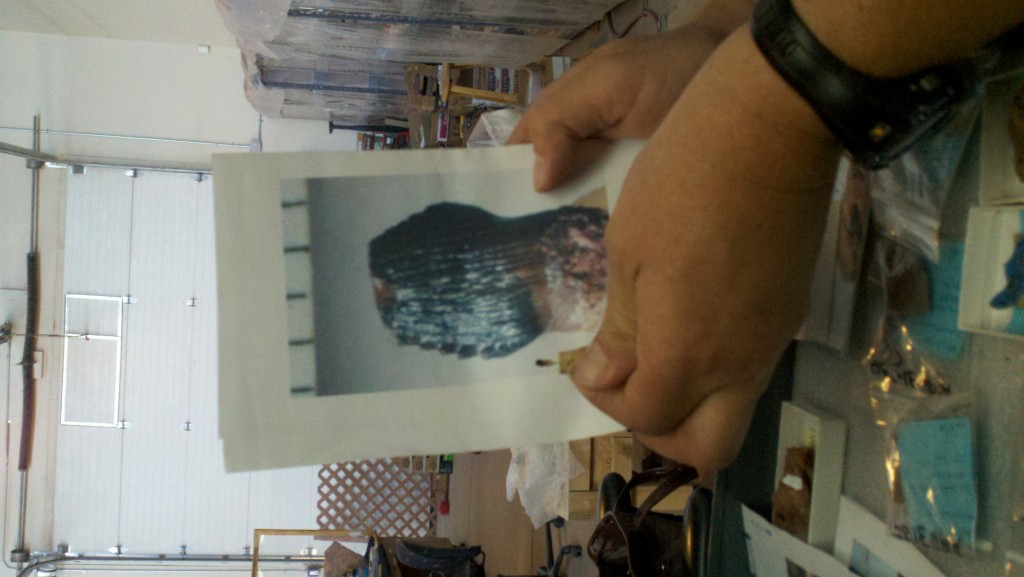
one of the new reptile tooth morphotypes. This is the possible plant-eating dinosaur/croc tooth. St. George, Utah, May 2013 | Photo by Sarah Isaacson, St. George News

Possibly a small meat-eating dinosaur tooth still in original matrix. St. George, Utah, May 2013 | Photo by Sarah Isaacson, St. George News
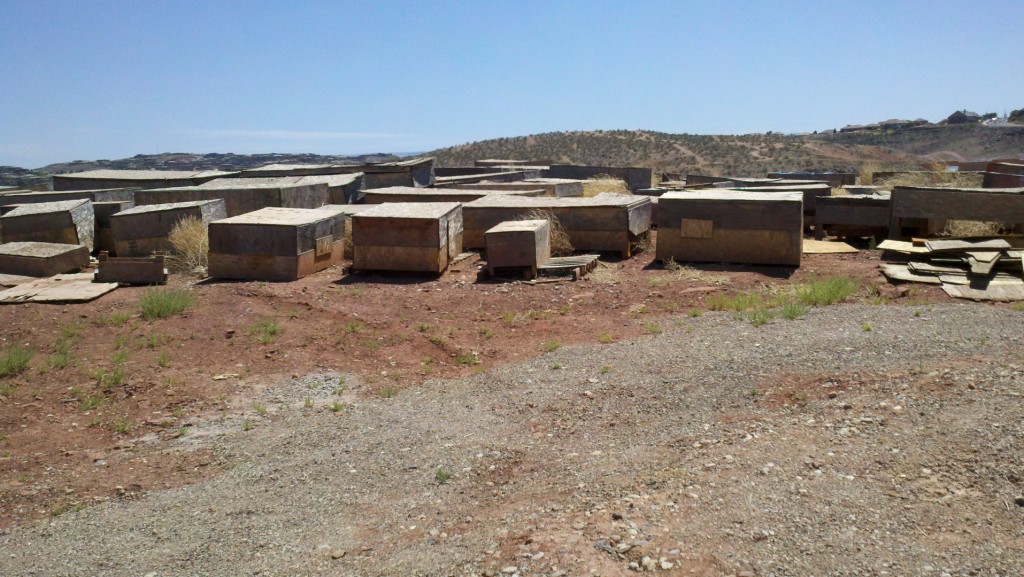
Homemade wooden boxes covering blocks of dinosaur tracks behind the Dinosaur Discovery Site, St. George, Utah, May 2013 | Photo by Sarah Isaacson, St. George News

Homemade wooden boxes covering blocks of dinosaur tracks behind the Dinosaur Discovery Site, St. George, Utah, May 2013 | Photo by Sarah Isaacson, St. George News

Original discovery tracks at SPP tracksite and examples of large theropod tracks from the same site. A-B, Anomoepus trackway (UMNH VP 23330) with hand and foot tracks, part of the original discovery site by Alden Hamblin. C-D, Examples of large theropod tracks (probably Kayentapus and specimens were not collected). Washington County, Utah, 2013 | Photo by and courtesy of Andrew Milner, St. George News

Part and counterpart a Cycad leaf. Washington County, Utah, 2013 | Photo by and courtesy of Andrew Milner, St. George News

Back half of a nearly complete fish fossil from SPP plant locality (found by Bob Baldazzi). Washington County, Utah, 2013 | Photo by and courtesy of Andrew Milner, St. George News
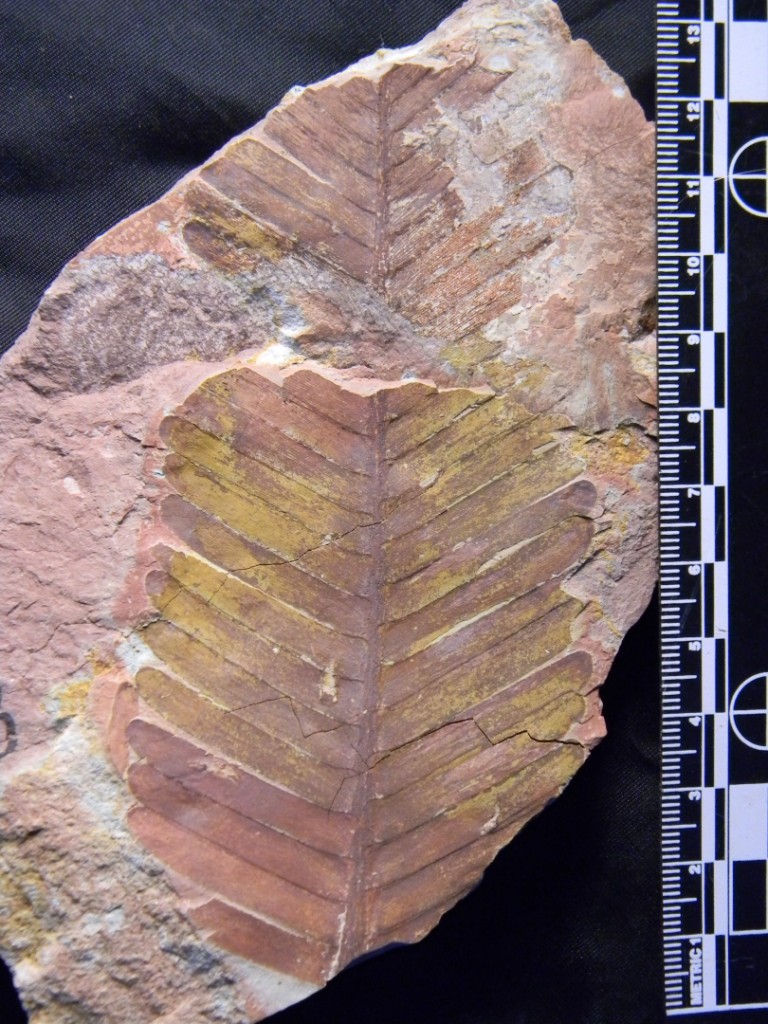
Large, well-preserved cycad leaf. Washington County, Utah, spring 2013 | Photo by and courtesy of Andrew Milner, St. George News
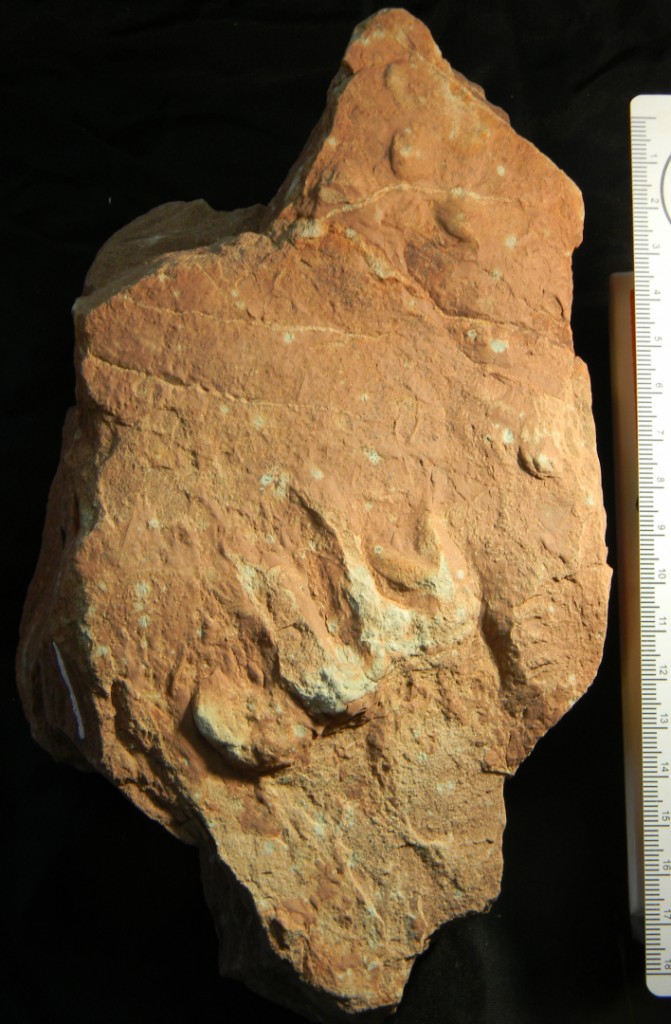
Dinosaur swim track from SPP plant locality,Washington County, Utah, spring 2013 | Photo by and courtesy of Andrew Milner, St. George News
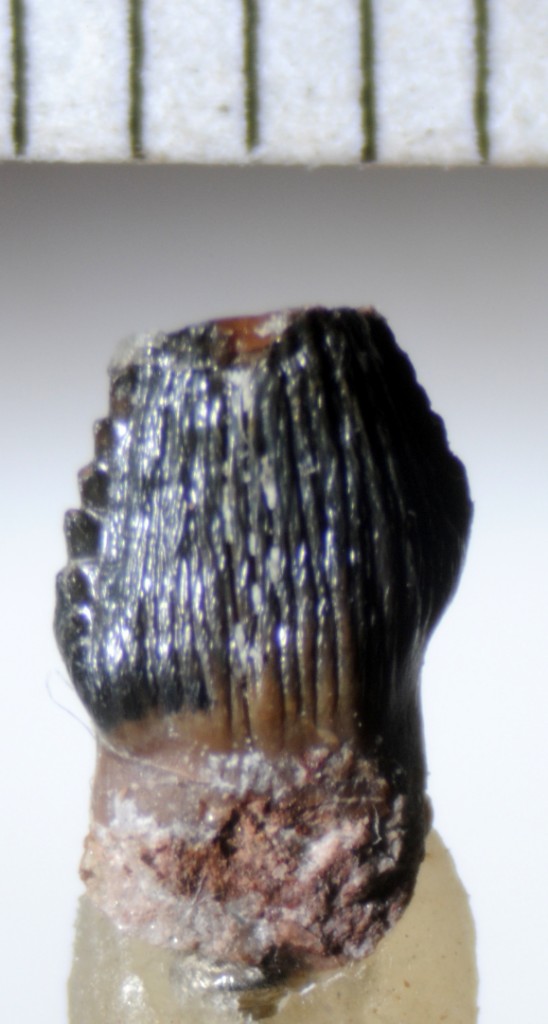
Leaf-shaped tooth from the SPP plant locality. This is one of the new tooth morphotypes. It could be from a plant-eating dinosaur similar to Scutellosaurus or from an unknown extinct relative of modern crocodiles. Scale is in millimeters, Washington County, Utah, spring 2013 | Photo by and courtesy of Don DeBlieux, Utah Geological Survey, St. George News
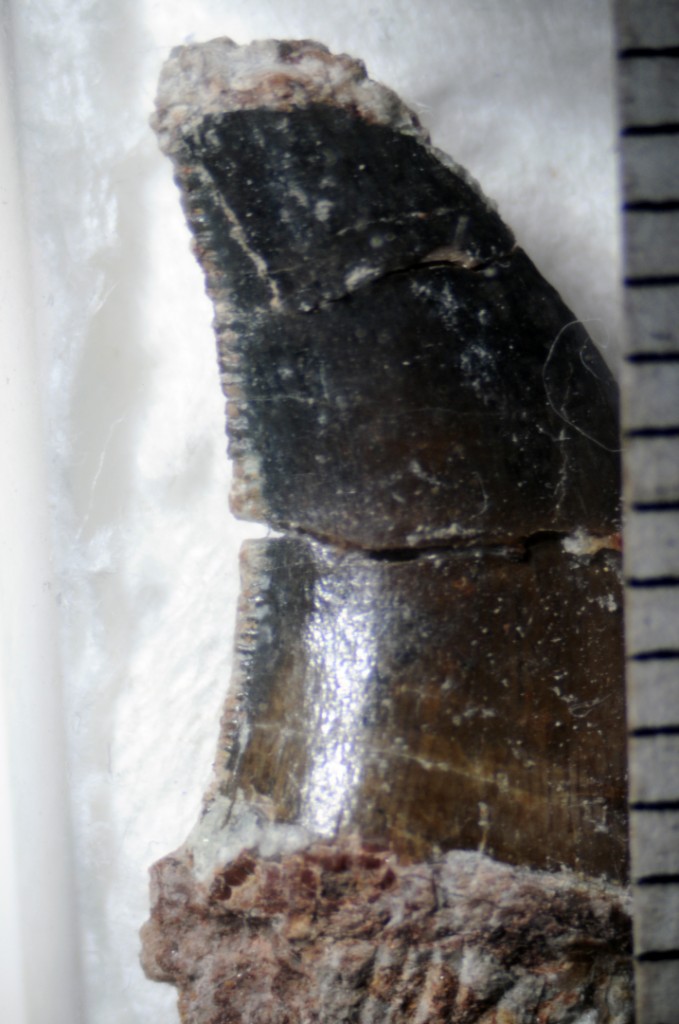
Meat-eating dinosaur tooth from Southern Parkway Project plant locality. Scale in millimeters, Washington County, Utah, spring 2013 | Photo by and courtesy of Don DeBlieux, Utah Geological Survey, St. George News

SGDS and Utah Friends of Paleontology volunteers and staff doing surface excavation and detailed cleaning of the Southern Parkway Project tracksite,Washington County, Utah, spring 2013 | Photo by and, courtesy of Andrew Milner, St. George News
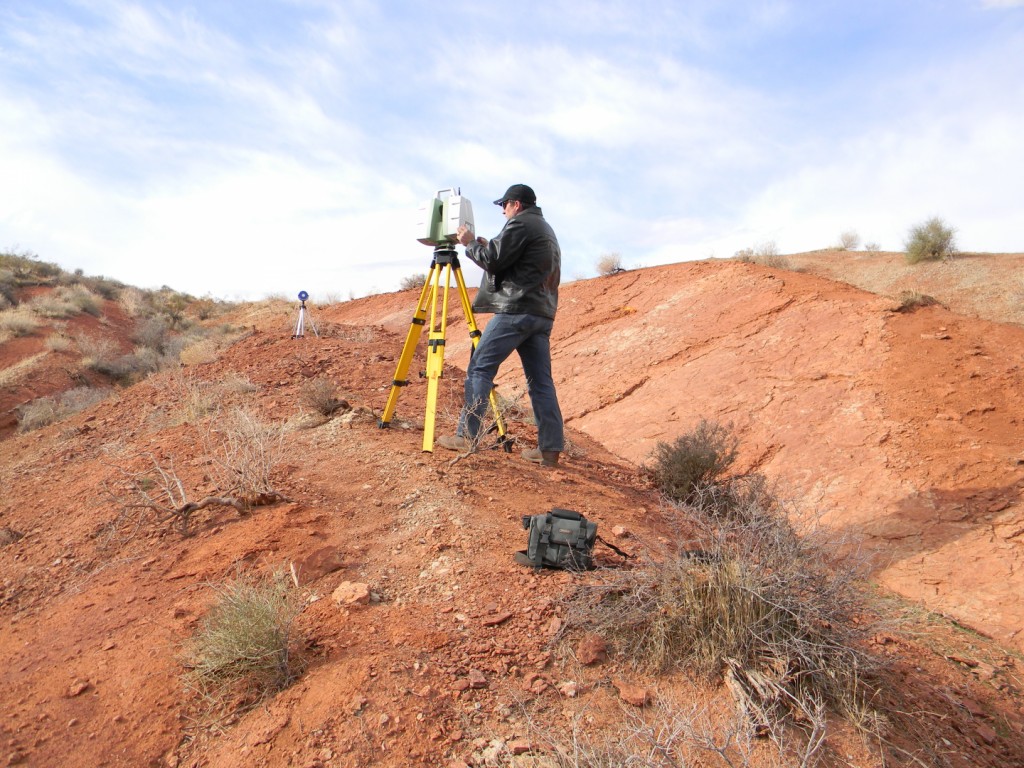
Burt Christiansen of Sunrise Engineering laser scanning tracksite, Washington County, Utah, spring 2013 | Photo by and courtesy of Andrew Milner, St. George News

Andrew Milner using a Stihl concrete saw to salvage dinosaur tracks, Washington County, Utah, spring 2013 | Photo by Linda Hoernke, courtesy of Andrew Milner, St. George News
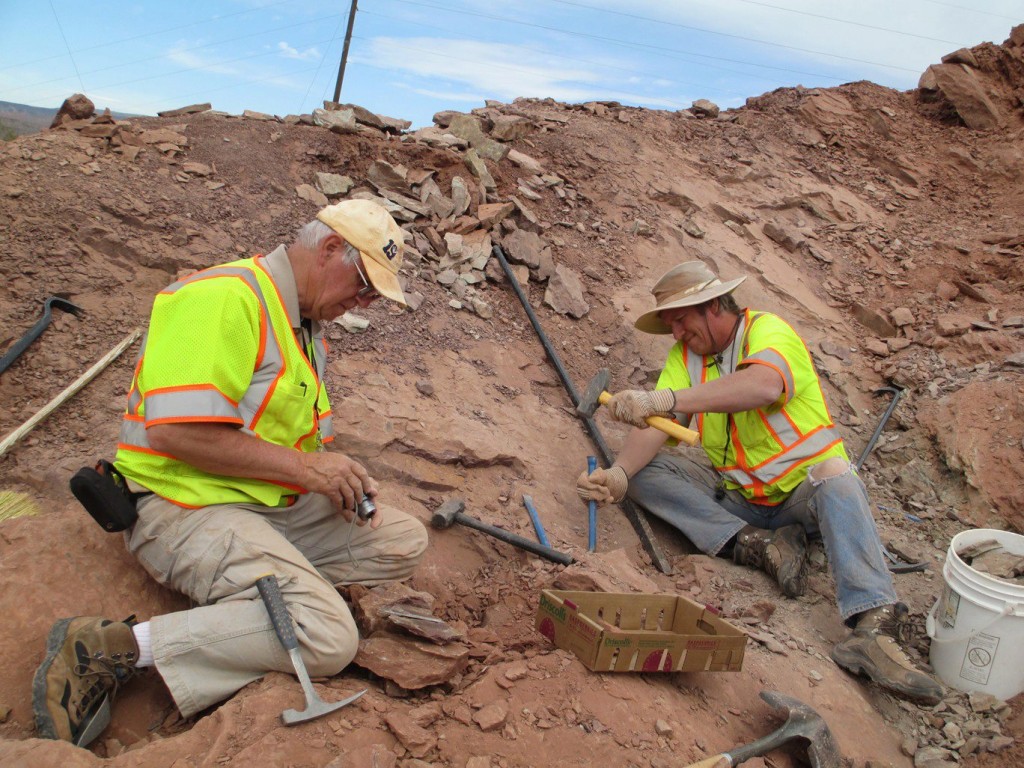
Nearly all of the excavation at the SPP plant locality was done using hand tools over several weeks. Fred Overkamp on left; Andrew Milner on right, Washington County, Utah, spring 2013 | Photo by Linda Hoernke, courtesy of Andrew Milner, St. George News
Related Posts
- Southern Parkway road construction unearths ancient ruins; what archaeologists say
- Zion celebrates Earth Day, National Park Week with sustainability, resource-oriented events
- Learn about rock art near and far
- Archaeology Day offers tour of Grand Canyon’s unique history
- BLM sponsoring tour of Arizona archaeology sites
- Spring Equinox sunset observation at Parowan Gap
- Archaeological Tour of the Southern Parkway
- UDOT Archaeologists Transport the Public Through the Past and the Future
Email: [email protected]
Twitter: @sarahisaacson1
Copyright St. George News, StGeorgeUtah.com Inc., 2013, all rights reserved.

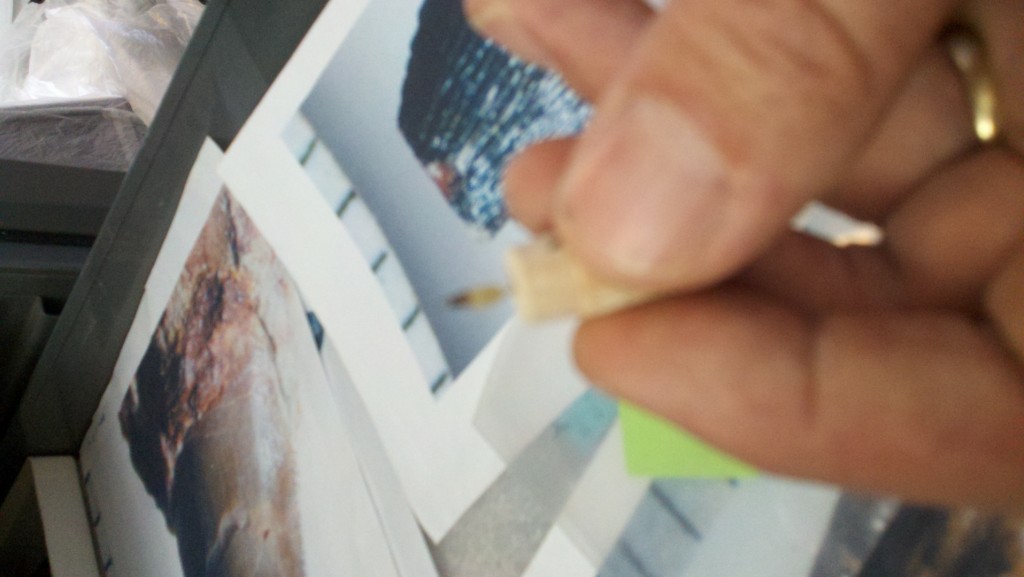

Good stuff. Thanks. Would help if the vertical shots were rotated to be vertical however, so I don’t have to turn the laptop on its side.
It was a special privilege and a great learning experience, to have been able to participate in the digs conducted before construction of the Southern Parkway began along the Washington Dam Road.